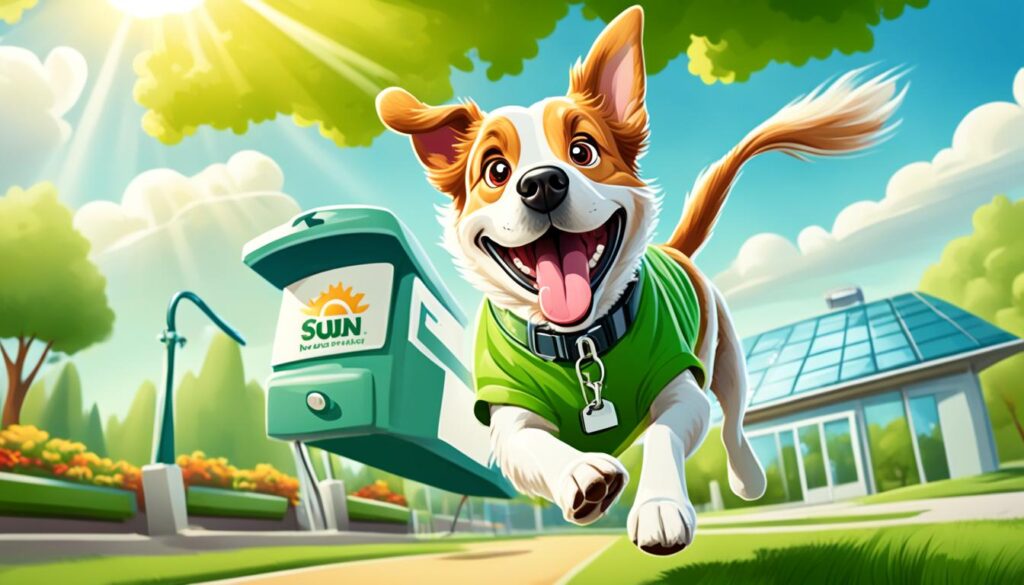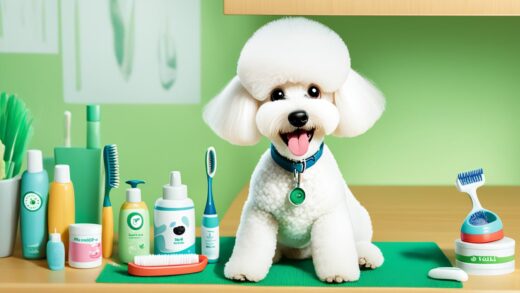Vet Visits Made Easy: Preparing Your Dog
Did you know that over 40% of dog owners experience difficulty in taking their furry friends to the veterinarian?
Visiting the vet is essential for your dog’s health and well-being, but it can often be a stressful experience for both you and your four-legged companion. The unfamiliar environment, strange sounds, and potential uncomfortable procedures can trigger fear and anxiety in dogs.
Fortunately, with some proper preparation and helpful tips, you can make vet visits a more positive and stress-free experience for your dog. By addressing their fears and taking the necessary steps to prepare them beforehand, you can alleviate their anxiety and ensure a smoother vet visit.
Key Takeaways:
- Over 40% of dog owners find it challenging to take their dogs to the vet.
- Proper preparation is key to making vet visits more positive for your dog.
- Fear of vet visits can stem from the unfamiliar environment and potential discomfort.
- Introducing your dog to different people and situations can help reduce their fear.
- Teaching your dog relaxation techniques and positive associations with being touched is important.
Why Dogs Fear Vet Visits
Many dogs develop a fear of vet visits due to various factors that contribute to their anxiety. Understanding these reasons can help you address and alleviate your dog’s fears, making vet visits a more positive experience for both of you.
Unfamiliar Environment
The veterinary clinic is an unfamiliar environment for dogs, which can trigger fear and anxiety. The sterile smells, unfamiliar sounds, and presence of other animals can make your dog feel uneasy and on high alert.
Potential for Uncomfortable Procedures
During vet visits, dogs may experience uncomfortable procedures such as vaccinations, blood tests, or physical examinations. The anticipation of these procedures can create anxiety and fear in your dog, especially if they have had negative experiences in the past.
“The unfamiliar environment, unusual sounds and smells, and the potential for uncomfortable procedures can all contribute to a dog’s fear of vet visits.”
Naturally Shy or Uncomfortable Around New People
Some dogs are naturally shy or uncomfortable around new people, which can add to their anxiety during vet visits. The presence of unfamiliar veterinary staff and the handling involved can further exacerbate their stress levels.
To help address your dog’s fear of vet visits, it’s important to provide them with proper socialization, positive associations, and training. By doing so, you can help them feel more calm and relaxed during their veterinary appointments.
Socializing Your Dog
Socializing your dog from a young age is crucial for their development and overall well-being. It helps them feel more comfortable around new people and unfamiliar environments. By introducing your dog to different people and situations, you can build their trust and reduce fear.
Positive experiences with strangers also play a significant role in making veterinary visits less stressful for your dog.
When socializing your dog, it is important to focus on positive reinforcement and rewards. Make sure to expose them to a variety of people, including men, women, children, and individuals of different ages and ethnic backgrounds. This will help your dog become more adaptable and sociable.
Additionally, providing opportunities for your dog to interact with other well-behaved dogs can further enhance their socialization skills. Organized playgroups or visits to the dog park can be beneficial in this regard.
Building Trust
Building trust is an essential component of socializing your dog. One effective way to build trust with your dog is through consistent training and positive experiences. Use treats, praise, and affection to reward your dog for good behavior, such as calm and polite greetings with strangers.
“By creating positive associations with new people and environments, you can help your dog feel more at ease during vet visits,” says Dr. Emily Johnson, veterinarian at ABC Animal Hospital.
Remember to be patient and give your dog time to adjust and feel comfortable in new situations. Avoid forcing them into overwhelming or anxiety-inducing situations, as this can have the opposite effect and potentially reinforce fear or anxiety.

Benefits of Socialization
The benefits of socialization extend beyond vet visits. A well-socialized dog is more likely to exhibit appropriate behavior, such as being calm and friendly around people and other animals. They are also less likely to develop behavioral problems, such as aggression or anxiety.
A study conducted by the American Veterinary Society of Animal Behavior (AVSAB) found that dogs lacking proper socialization were more likely to exhibit fear-based behaviors, including aggression, separation anxiety, and fear of unfamiliar situations.
| Benefits of Socialization | Non-Socialized Dogs | Socialized Dogs |
|---|---|---|
| Reduced fear and anxiety | More likely to exhibit fear-based behaviors | Less likely to be fearful in new situations |
| Improved behavior | Higher likelihood of aggression and anxiety | Less likely to develop behavioral problems |
| Better overall well-being | Higher levels of stress and discomfort in new environments | More adaptable and comfortable in various settings |
As seen in the table above, socializing your dog contributes to their overall well-being and can significantly impact their behavior and temperament in a positive way.
Remember, socialization is an ongoing process, and it is never too late to start. Consistency and positive reinforcement are key to helping your dog feel confident around new people and in veterinary settings.
Teaching Your Dog to Relax
Preparing your dog for vet visits involves teaching them relaxation techniques and ensuring they are comfortable with being touched. By starting with gentle touches in a relaxed state and using positive reinforcement, you can help your furry friend develop a positive association with being handled.
“Relaxation is the key to a stress-free vet visit.”
When teaching your dog to relax, it’s important to start with small steps and gradually progress to more challenging tasks. Begin by touching their ears, feet, and mouth while they are in a calm and relaxed state. Use a soothing voice and gentle strokes to create a positive experience. Reward them with treats or praise to reinforce this behavior.
Here is a step-by-step guide to help you teach your dog to relax:
- Find a quiet and comfortable space where you and your dog can relax without distractions.
- Start by gently touching your dog’s ears, feet, and mouth for a few seconds at a time.
- Observe your dog’s body language for any signs of discomfort or stress. If they become anxious, take a step back and try again later.
- Gradually increase the duration of each touch session, always paying attention to your dog’s comfort level.
- Use positive reinforcement techniques, such as treats or verbal praise, whenever your dog remains calm and relaxed during the touch sessions.
- Repeat the process regularly to reinforce the behavior and help your dog build confidence.
Remember to be patient and understanding with your dog throughout the training process. Every dog is unique, and it may take some time for them to become comfortable with being touched in certain areas. By using positive reinforcement and creating a calm environment, you can help your dog develop relaxation skills that will come in handy during vet visits.
| Benefits of Teaching Your Dog to Relax | Techniques to Try |
|---|---|
| Reduced anxiety during vet visits | Gentle touches in relaxed state |
| Improved cooperation during procedures | Positive reinforcement with treats |
| Easier grooming sessions | Soothing voice and gentle strokes |
| Enhanced overall well-being | Creating a calm environment |
Exercising Your Dog
If your dog is not injured and is going for a routine checkup, providing exercise before the vet visit can help release excess energy and reduce anxiety. It’s important to understand that a tired dog is often a calmer dog, so engaging them in physical activity can help them feel more at ease during the visit.
There are various ways to release your dog’s energy before heading to the vet. One effective option is to take them for a long walk or jog. This not only helps burn off some energy but also allows them to explore and mentally stimulate themselves.
Another great option is to play a game of fetch. This activity can be done in your backyard or a nearby park. Throwing a ball or a frisbee for your dog to chase after helps them use both their physical and mental energy, reducing any restlessness or anxiety they may be feeling.
It’s important to note that the type and duration of exercise should be appropriate for your dog’s breed, age, and health condition. Consult your veterinarian to ensure that you are providing the right amount of exercise for your furry friend.
| Benefits of Exercising Your Dog Before a Vet Visit |
|---|
| 1. Releases excess energy |
| 2. Reduces anxiety and restlessness |
| 3. Increases mental stimulation |
| 4. Promotes a calm and relaxed demeanor |
| 5. Enhances the overall well-being of your dog |
By engaging in physical activities and exercising your dog before a vet visit, you can help create a more positive and stress-free experience for your furry companion. The combination of mental and physical stimulation can help your dog feel more at ease, reducing the chances of restlessness or anxiety during the visit.

Notifying the Vet Staff
If your dog exhibits aggression towards other dogs or has a history of aggressive behavior, it is crucial to inform the veterinary staff prior to your visit. By notifying them in advance, the staff can take necessary precautions to ensure the safety and well-being of all animals and humans involved.
When you inform the vet staff about your dog’s aggressive tendencies, they can make special arrangements to keep your dog separate from other patients. This helps minimize stress and potential conflicts during the visit, ensuring a safer and more comfortable experience for everyone.
By providing this important information, you are helping the staff create a controlled environment that prioritizes the safety of all animals. This allows them to better handle your dog’s specific needs and ensure that both you and your furry companion feel supported throughout the visit.
Key Points:
- Notify the vet staff about your dog’s aggression or history of aggressive behavior.
- Informing the staff ahead of time allows them to make arrangements to keep your dog separate from other patients.
- This helps reduce stress and potential conflicts during the visit.
Remember, open communication is essential for a successful vet visit, particularly when it comes to dogs with aggressive tendencies. Notify the vet staff, and they will work with you to create a safe and positive experience for your beloved pet.
Staying Calm During the Visit
Dogs are sensitive creatures, and they can easily pick up on their owner’s emotions. This means that if you are feeling nervous or anxious during a vet visit, your dog will sense it too, potentially making them more anxious. To ensure your dog’s visit is as stress-free as possible, it is crucial to maintain a calm and positive attitude throughout the appointment.
We understand that it can be challenging to stay calm when you are worried about your furry friend’s well-being. However, your dog looks to you for guidance and reassurance. If they sense that you are calm and confident, it will help them feel more secure and relaxed in the unfamiliar environment of the vet’s office.
Why staying calm is essential:
“Dogs are excellent at picking up on their owner’s emotions. If you appear anxious or nervous, your dog will likely mirror those feelings, potentially intensifying their own anxiety during the vet visit.” – Dr. Emily Johnson, DVM
To help you stay calm and positive during the visit, here are some tips:
- Take deep breaths and try to relax your body and mind.
- Remind yourself that you are there for your dog’s benefit and well-being.
- Focus on the positives, such as the expertise of the veterinary staff and the opportunity to address any health concerns.
- Engage in positive self-talk, reinforcing that you are doing the best you can for your beloved pet.
- Visualize a positive outcome and imagine your dog feeling calm and comfortable during the visit.
Remember, staying calm and positive is not only beneficial for your dog but also for yourself. By cultivating a positive mindset, you can approach the vet visit with greater ease and ensure a smoother experience for everyone involved.

Conclusion
Preparing your pet for vet visits is essential in ensuring a stress-free experience for both you and your furry friend. By following these helpful tips, you can alleviate their fears and create a more positive environment.
Firstly, socializing your dog from a young age plays a crucial role in their comfort around new people. Introduce them to different individuals and situations, building trust and reducing anxiety. Positive experiences with strangers will make vet visits less alarming for your pet.
Next, teaching relaxation techniques and getting your dog accustomed to being touched is vital. Gently touch their ears, feet, and mouth while they are in a relaxed state. Use positive reinforcement and rewards to foster a positive association with being handled.
Additionally, providing exercise before the vet visit can help release excess energy and reduce anxiety. Taking your dog for a walk or engaging in a game of fetch will help them feel more at ease during the visit.
Remember to stay calm and positive throughout the experience, as dogs are sensitive to their owner’s emotions. By maintaining a calming presence, you can help alleviate stress and create a more pleasant vet visit for your furry companion.
















